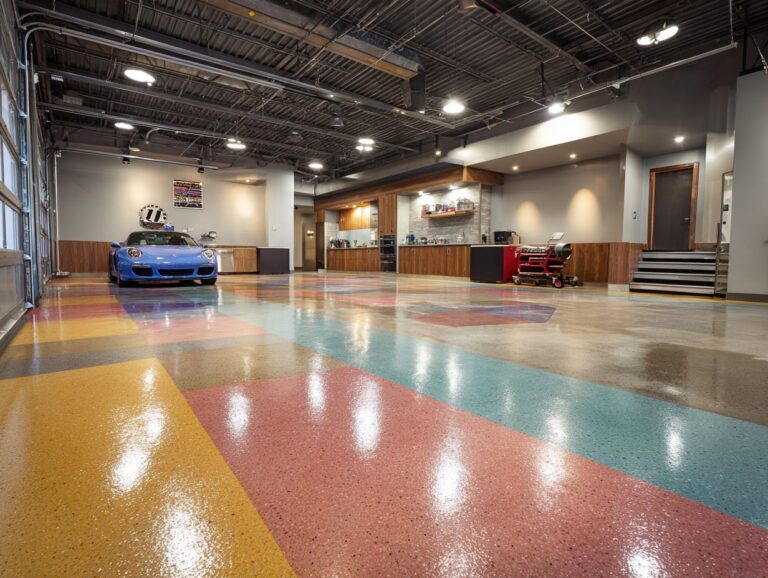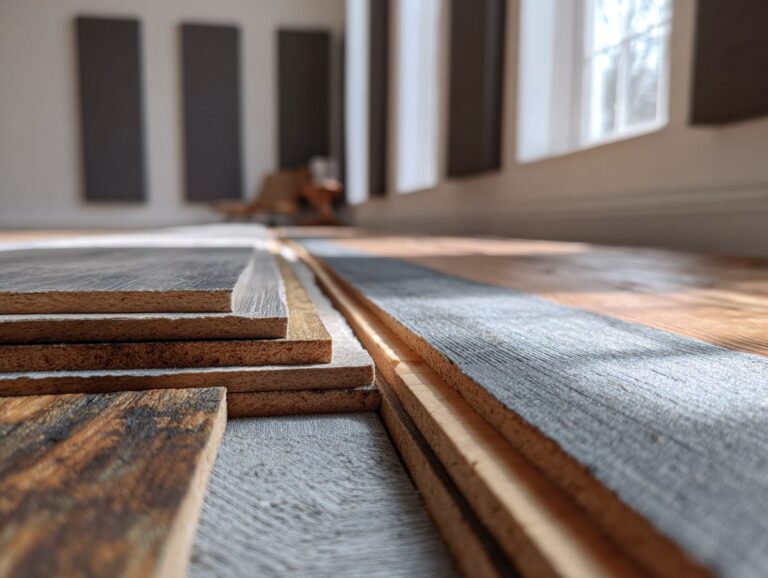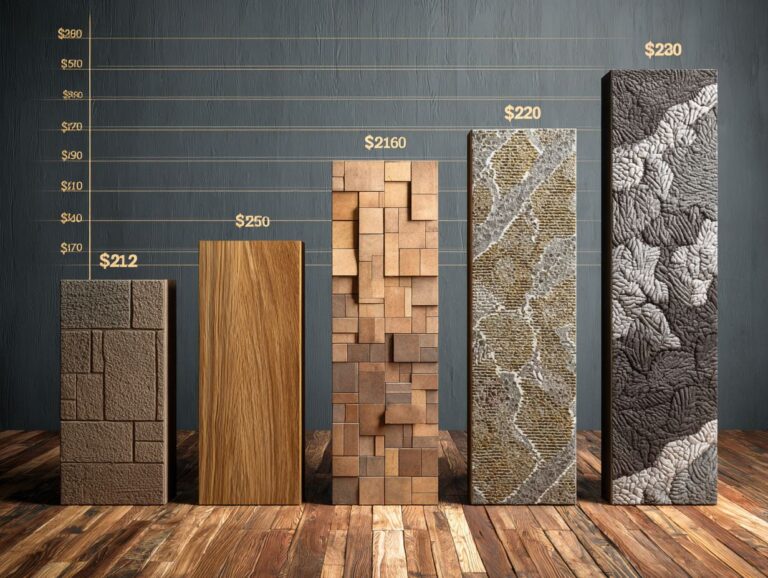Local vs Imported Flooring – Environmental Impact
When choosing flooring materials, it’s important to think about how local materials affect the environment compared to those that are imported. With increasing environmental awareness, choosing sustainable options like hardwood flooring or engineered hardwood from brands like Lumber Liquidators can make you an eco-conscious choice advocate. This article talks about the pros and cons of picking flooring made nearby versus flooring from other countries. It will guide you in selecting what’s best for your home and the environment. Prepare to change your space in an eco-friendly way!
Key Takeaways:
Contents
- Environmental Impact Overview
- Flooring Environmental Impact Stats
- Local Flooring: Benefits and Drawbacks
- Imported Flooring: Benefits and Drawbacks
- Comparative Analysis of Carbon Footprint
- Regulations and Standards
- Consumer Choices and Behavior
- Frequently Asked Questions
- What is the difference between local and imported flooring?
- What is the environmental impact of local flooring?
- What is the environmental impact of imported flooring?
- Why is it important to consider the environmental impact of flooring?
- How can I determine if a flooring product is locally sourced?
- Are there any other benefits of choosing local flooring over imported flooring?
Definition of Local Flooring

Local flooring means products that come from and are made in a certain area. This helps the environment and supports nearby businesses by using renewable materials.
Oak and hickory from Missoula give your home a unique look and help lower transportation emissions. Purchasing from local suppliers such as Missoula Lumber or Big Sky Wood Products means you are putting money back into your community.
Purchasing from nearby sources often results in higher quality materials and expert craftsmanship. Consider visiting local showrooms to see samples and discuss options, as this direct engagement can also lead to customized solutions for your flooring needs.
Definition of Imported Flooring
Imported flooring includes products brought in from other countries, which often encompasses a wider selection but raises concerns about environmental impact and sustainability in the global supply chain.
When considering imported flooring, evaluate its carbon footprint stemming from transportation and manufacturing. For instance, hardwood sourced from South America may involve significant shipping emissions, while laminate from Europe could have a more efficient transport route.
To make more sustainable choices, look for certifications like the Forest Stewardship Council (FSC) or consider locally sourced alternatives. Using tools like life cycle assessment software can evaluate how your flooring options impact the environment, helping you decide between aesthetics and eco-friendliness.
Environmental Impact Overview
Knowing how flooring options affect the environment is important for people who want choices that match their eco-friendly values and health needs. For an extensive analysis of how different flooring materials can impact your long-term choices, our comprehensive study of flooring lifespan by material sheds light on replacement cycles and sustainability considerations.
Flooring Environmental Impact Stats
Flooring Environmental Impact Stats
Carbon Sequestration: Eco-Friendly Capability
Carbon Sequestration: Carbon Sequestration Efficiency
The Flooring Environmental Impact Stats data shows how different environmentally-friendly flooring materials can store carbon. This information is essential for learning about the environmental benefits of these materials and how they help reduce climate change.
Carbon Sequestration focuses on the ability of flooring materials to absorb carbon dioxide from the atmosphere, thus reducing the overall carbon footprint. Among the materials analyzed, cork shows the highest sequestration capability at 14.7 units per year This method captures carbon more effectively than any other approach. This highlights cork as a superior choice for environmentally conscious consumers looking to minimize their carbon footprint through flooring choices.
- Bamboo, with a sequestration rate of 6.88 units per year, offers a strong alternative, particularly known for its rapid growth rate and renewable nature. Its efficiency compared to other materials provides a balanced choice for those prioritizing sustainability and aesthetics.
- Hardwood’s sequestration rate stands at 4.04 units per year, lower than both bamboo and cork. Hardwood is still widely chosen because it lasts long and looks classic, but it has a bigger negative effect on the environment than other choices.
When assessing Carbon Sequestration Efficiency, bamboo’s performance is noteworthy. It is 70% more efficient than hardwood, reflecting its superior ability to sequester carbon relative to its growth and harvesting cycles. However, bamboo is less efficient than cork. 243.68%, highlighting cork’s exceptional capacity to sequester carbon and act as a sustainable flooring option.
Overall, the data highlights the need to choose flooring materials with consideration for their environmental effect. While cork leads in sequestration efficiency, bamboo offers a significant advantage over traditional hardwood, promoting a move towards more sustainable flooring solutions. By learning about these patterns, buyers and producers can make smart decisions that help preserve the environment and cut down on carbon emissions.
Importance of Sustainable Flooring
Sustainable flooring options contribute to a healthier home environment, reducing carbon footprints and improving indoor air quality through eco-friendly materials and manufacturing practices.
For example, American-made hardwoods, such as oak or maple, often have lower levels of volatile organic compounds (VOCs) compared to PVC alternatives, which can release harmful toxins.
Studies indicate that using materials certified by the Forest Stewardship Council (FSC) can diminish indoor air pollution. Bamboo flooring is a quickly renewable choice that is both sustainable and long-lasting.
When choosing flooring, look into certifications like GREENGUARD to make sure you select products that help create a healthier home. To further enhance your selection, benefit from understanding recycled and reclaimed flooring options which promote sustainability and uniqueness.
Global vs. Local Supply Chains
The contrast between global and local supply chains highlights significant differences in transportation impact, resource utilization, and overall sustainability of flooring products.
Local supply chains benefit from reduced transportation distances, resulting in lower carbon emissions and fresher products. For example, getting hardwood from a nearby mill helps local businesses and reduces the environmental harm from transporting goods over long distances.
Global supply chains offer greater variety and availability, allowing access to materials that may not be locally produced, such as exotic hardwoods. This choice between being eco-friendly and offering a range of products makes businesses consider their priorities, balancing environmental issues with the need for different flooring options.
Local Flooring: Benefits and Drawbacks
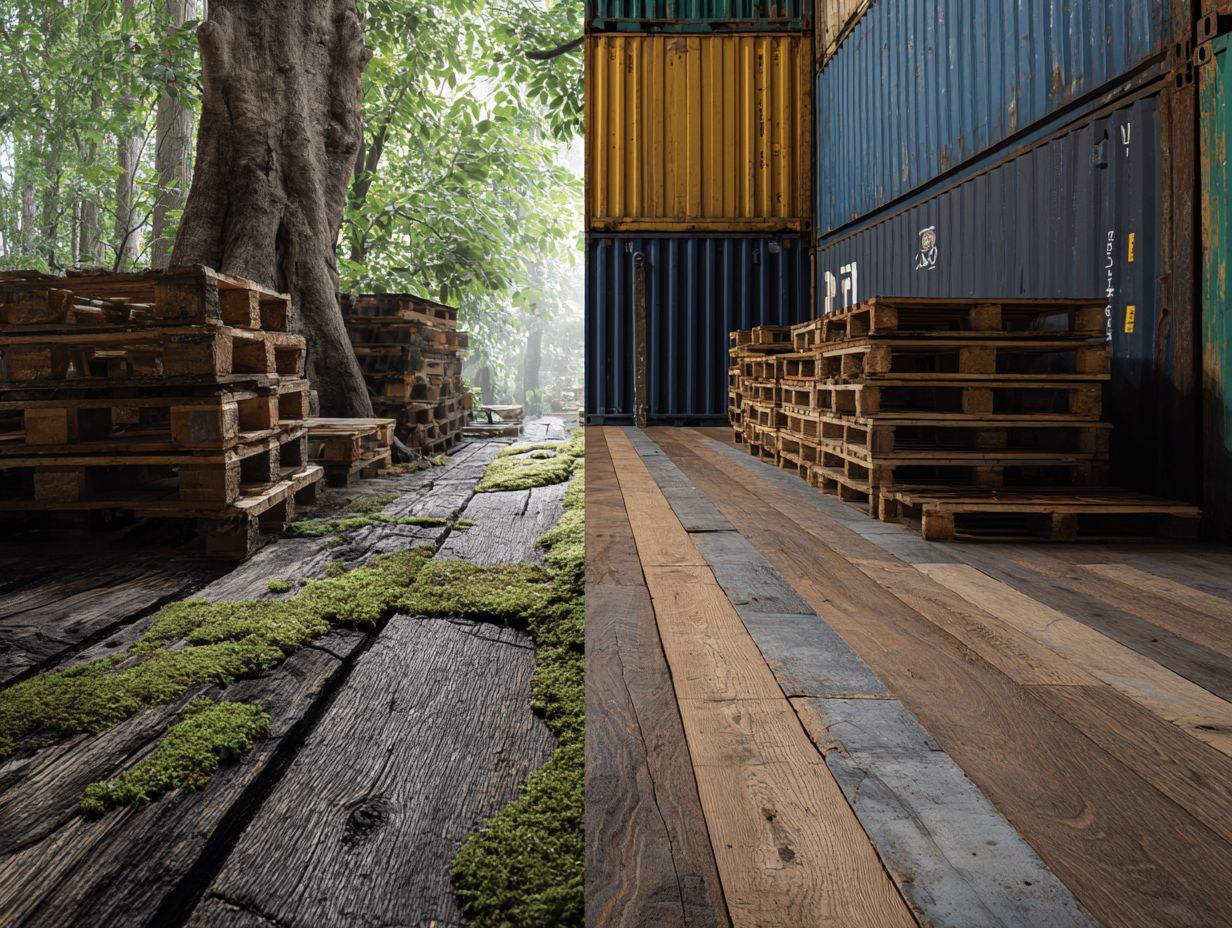
Choosing flooring from nearby sources offers many benefits, such as supporting the local economy and cutting down on transportation emissions.
However, it might have drawbacks like limited availability and higher cost.
Resource Utilization
Local flooring products are often derived from sustainably managed forests, ensuring responsible resource utilization that benefits both consumers and the environment.
For example, North American tamarack, known for its durability and aesthetic appeal, is a fantastic alternative to imported species like merbau. Sourcing tamarack locally minimizes environmental impact and supports local economies.
Select products with the Forest Stewardship Council (FSC) label to confirm materials are obtained in an environmentally friendly way. Purchasing certified local items reduces carbon emissions and helps preserve local nature. It backs responsible forestry practices that safeguard the environment for those who come after us.
Carbon Footprint of Local Production
The carbon footprint of locally produced flooring is significantly lower due to reduced transportation distances and energy-efficient manufacturing processes.
For instance, a study by the Forest Stewardship Council revealed that choosing locally sourced hardwood flooring can reduce carbon emissions by up to 60% compared to imported options.
A case study demonstrated that a local manufacturer in Oregon generated 30% less CO2 per square foot than a similar company importing wood from overseas.
To get the most out of these benefits, try buying flooring from local mills and check for certifications such as FSC or SFI that guarantee environmentally responsible methods. This supports local economies and encourages sustainable building methods.
Impact on Local Ecosystems
Sustainable harvesting practices in local flooring production help protect local ecosystems, ensuring that natural habitats are preserved and biodiversity is maintained.
Using techniques like selective logging and planting trees helps wildlife and follows rules such as the Lacey Act, which bans illegal timber trading.
For example, the Forest Stewardship Council (FSC) certification guarantees that the wood is sourced responsibly. Local producers can also adopt agroforestry, integrating trees with crops to promote soil health and provide habitat.
These practices increase ecological stability and can draw in consumers who care about the environment, which helps economic growth while keeping nature in balance.
Imported Flooring: Benefits and Drawbacks
While flooring from other countries offers people more choices in designs and materials, it also brings problems like pollution from shipping and using up natural resources.
Transportation Emissions
Transportation emissions from imported flooring significantly contribute to its overall carbon footprint, with studies showing an increase in emissions by up to 40% compared to local options.
When bringing in flooring materials from other places, how far they have to travel is very important. For example, importing bamboo from Asia can result in over 1,000 miles of transport, increasing emissions substantially.
Shipping methods also play a significant role; freight shipping is generally less eco-friendly than air freight, which emits more CO2 per ton. Consider products like luxury vinyl or laminate, which often require less energy in transportation compared to solid wood options.
By sourcing materials locally or regionally, consumers can help mitigate these environmental impacts and support sustainable practices within their communities.
Resource Depletion in Source Countries
The extraction of hardwoods in source countries can lead to resource depletion, threatening biodiversity and local communities if not managed sustainably.
Effective responsible sourcing practices are essential to mitigate these impacts.
For example, consumers can look for certifications like Forest Stewardship Council (FSC) or Programme for the Endorsement of Forest Certification (PEFC) when buying flooring. These labels show that the wood comes from forests that are managed with care for the environment, helping to preserve local ecosystems.
Importing companies should establish relationships with suppliers who practice reforestation and implement transparent supply chains. By supporting these practices, consumers can significantly contribute to protecting the environment and preserving biodiversity.
Impact on Global Ecosystems
Imported flooring can have adverse effects on global ecosystems, including habitat destruction and increased carbon emissions, raising questions about the long-term sustainability of such products.
The harvesting of timber for imported flooring often leads to deforestation, which compromises biodiversity. For example, the logging practices in Southeast Asia have resulted in the loss of critical habitats for endangered species such as orangutans.
Carbon emissions rise as trees are removed, reducing the planet’s ability to sequester carbon. To mitigate these impacts, consumers can opt for certified sustainable products, such as those marked by the Forest Stewardship Council (FSC), ensuring that the wood is sourced responsibly and legally.
Comparative Analysis of Carbon Footprint

A study comparing the carbon footprint of local and imported flooring shows noticeable differences in their effects on the environment. This emphasizes how important it is for consumers to make informed decisions. Those curious about environmentally friendly options might appreciate our guide on recycled and reclaimed flooring options.
Life Cycle Assessment of Local Flooring
A life cycle assessment (LCA) of local flooring typically shows a lower overall carbon footprint due to shorter transportation distances and sustainable manufacturing practices.
The LCA method examines various stages: acquiring materials, manufacturing products, utilizing them, and disposing of them when they are no longer useful.
For instance, consider Southern Pine from regional suppliers like Georgia-Pacific. Their sourcing involves less than 100 miles to local processing plants, significantly reducing carbon emissions from transportation.
The manufacturing phase for engineered wood flooring averages 3 months, incorporating eco-friendly adhesives. During disposal, options like recycling or repurposing can extend the flooring lifespan, contributing to environmental sustainability.
This simplified method can reduce carbon emissions by up to 40% when compared to flooring options from other countries.
Life Cycle Assessment of Imported Flooring
In contrast, the LCA of imported flooring often highlights higher carbon emissions and resource use due to longer supply chains and less regulated manufacturing practices.
For instance, a typical imported laminate flooring shows emissions of about 2.5 kg CO2e per square foot during transportation alone, depending on its origin such as China or Europe. In contrast, locally sourced products might only emit around 1 kg CO2e.
Many imported brands, like those from Karndean or Pergo, reportedly generate up to 25% waste during production, compared to high-efficiency manufacturers like Shaw Floors, which aim for 5% or less.
Proper disposal also remains a concern, with imported options often ending up in landfills, where they contribute to methane emissions.
Regulations and Standards
Rules and standards are necessary to make sure flooring materials are good for the environment, impacting items from both local and global suppliers.
Local Regulations on Sustainable Practices
Local regulations often mandate sustainable practices in the flooring industry, ensuring that harvesting and production methods minimize environmental impact.
For example, California has strict rules on where wood comes from, and companies must get certifications like the Forest Stewardship Council (FSC) label.
Businesses like Lumber Liquidators comply by sourcing materials from sustainably managed forests. This helps them steer clear of legal issues and improves their brand image, drawing in consumers who care about the environment.
Investing in sustainable practices often results in long-term cost savings, as efficient production methods reduce waste and lower material costs over time.
International Standards for Imported Flooring
International standards, such as the Forest Stewardship Council (FSC) certification, guide the importation of flooring products, promoting transparency and sustainability in sourcing.
Besides FSC certification, imported flooring products often meet important standards like those set by the American National Standards Institute (ANSI) and International Organization for Standardization (ISO).
For instance, ANSI A137.1 specifies performance criteria for ceramic tiles, ensuring durability and safety. Compliance can cost between $1,000 and $5,000, depending on how complicated the testing and certification are. However, it can make products more appealing and increase buyer confidence, helping manufacturers reach high-end markets.
Consumer Choices and Behavior
Consumers are becoming more aware of flooring choices, and their actions are changing. There is a growing demand for eco-friendly options, which is affecting the market.
Awareness of Environmental Impact
More people are learning about how flooring affects the environment, leading them to look for eco-friendly options that reduce their carbon emissions.
Recent surveys indicate that over 65% of consumers prioritize environmentally friendly materials when selecting flooring.
For instance, bamboo and cork are gaining traction due to their renewability and lower carbon emissions. The use of reclaimed wood is increasingly popular, as it reduces waste and promotes recycling.
Brands like Mohawk emphasize their eco-friendly practices, such as using low-VOC finishes and certifications like LEED.
This trend shows a big change in how people buy things, with sustainability being an important part of their choices.
Trends in Sustainable Flooring Choices
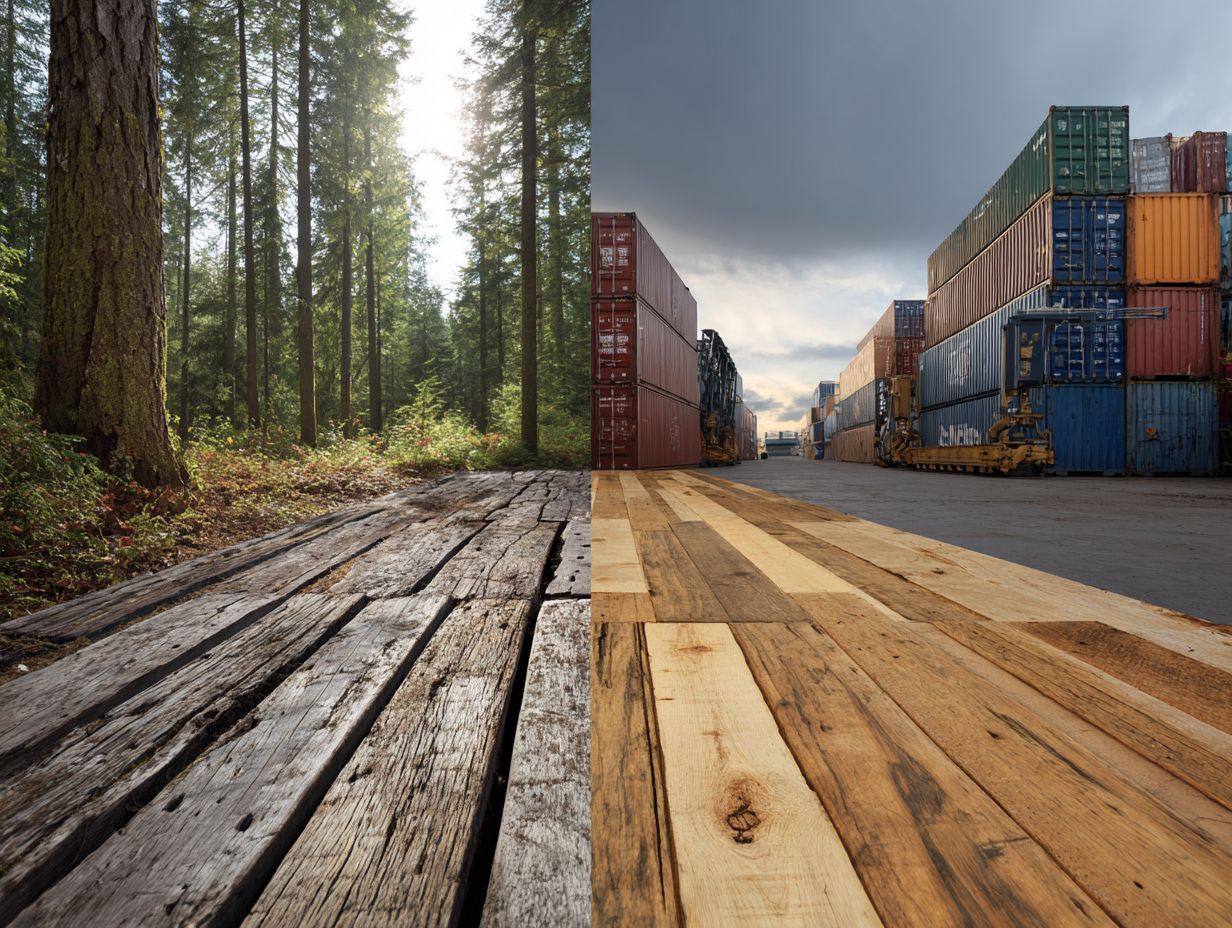
Trends in sustainable flooring choices indicate a shift towards eco-friendly materials, with a notable increase in the demand for products like engineered hardwood and ReNature vinyl plank flooring.
This growth reflects consumer awareness of environmental issues, with sales of sustainable flooring increasing by 15% annually.
For instance, ReNature’s vinyl planks are made from 100% recycled materials, appealing to cost-conscious customers with an average price of $3.50 per square foot. Similarly, engineered hardwood, which uses less wood than traditional options and often comes from sustainably managed forests, is gaining traction.
Homeowners are focusing on sustainability, both for environmental advantages and for modern design styles.
Summary of Environmental Impacts
A review of the environmental impacts of flooring reveals distinct advantages and disadvantages for both local and imported options, impacting carbon footprints and local ecosystems.
When choosing flooring, consider the sourcing and lifecycle. Locally-sourced hardwood can reduce transportation emissions and support regional economies, while bamboo offers a sustainable alternative due to its rapid growth cycle.
Conversely, imported options like exotic woods often involve extensive shipping, increasing their carbon footprint. To make an informed decision, look for certifications such as FSC (Forest Stewardship Council) that verify ethical sourcing.
Consider recycled materials like reclaimed wood or eco-friendly laminate, which can lower impact significantly. Thinking about these decisions is important to reduce your impact on the environment.
Frequently Asked Questions
What is the difference between local and imported flooring?
Local flooring is made and obtained within the same country, whereas imported flooring comes from other countries.
What is the environmental impact of local flooring?
Local flooring has a lower environmental impact compared to imported flooring as it requires less transportation, resulting in lower carbon emissions.
What is the environmental impact of imported flooring?
Imported flooring has a higher environmental impact due to the transportation emissions and the use of non-local resources, which can lead to deforestation and other environmental issues.
Why is it important to consider the environmental impact of flooring?
Flooring is very important for making a building environmentally friendly. Opting for eco-friendly flooring allows us to lower our carbon emissions and contribute to safeguarding the planet for those who come after us.
How can I determine if a flooring product is locally sourced?
You can check the product’s label or packaging to see where it was manufactured and sourced. You can also ask the retailer or manufacturer for this information.
Are there any other benefits of choosing local flooring over imported flooring?
Aside from the lower environmental impact, choosing local flooring also supports the local economy, reduces transportation costs, and can lead to faster delivery times.


